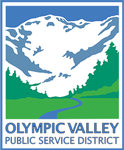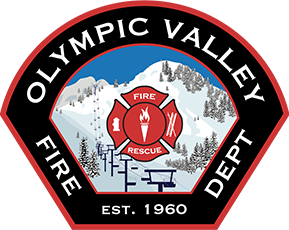Following are past capital projects completed by the Olympic Valley Public Service District.
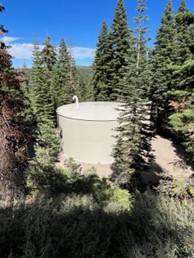
Zone 3 Tank
During the summers of 2022 and 2023, the District completed the repair and coating of two of our three water storage tanks, the West Tank and the Zone 3 Tank. Water storage tanks are critical assets in our water supply system, helping ensure sufficient water supply is available for domestic use, sanitation, and fire protection.
The West Tank is a 1,150,000-gallon tank located on the west end of the Valley near Washoe Drive. The tank was originally constructed for the 1960 Winter Olympics and was replaced in 1990 with the large, welded steel tank you see today. The Zone 3 Tank is a 135,000-gallon welded steel water storage tank that provides domestic and fire supply storage to approximately 25 homes within the District’s water service territory. It was also constructed in 1990 and is located at the south end of the Valley above Sierra Crest Trail.
The recoating projects included:
- Sand blasting and recoating the tank interior walls, floor, and roof structure
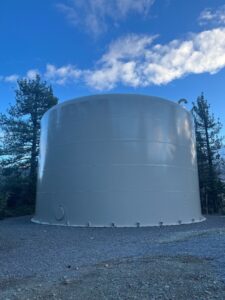
West Tank
- Installation of a climate control system (dehumidification) during the preparation and coating process
- Pressure washing and recoating the exterior of the tank
- Minor steel and welding repairs
- Temporary water supply and storage facilities to provide water while the tanks were out of service
Recoating at recommended intervals of every 25 years greatly increases the useful life of a water storage tank to more than 75 years before the need to replace.
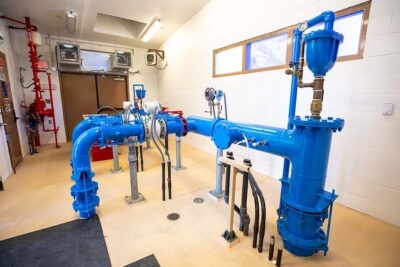 The District completed rehabilitation work on one of the system’s domestic water wells in May 2023. This well was originally put into service in 2011 and has a historic yield of 340 gallons per minute. The rehabilitation work was completed to investigate the integrity of the well components, ensure continued high water quality and well efficiency, and to extend the life of the well.
The District completed rehabilitation work on one of the system’s domestic water wells in May 2023. This well was originally put into service in 2011 and has a historic yield of 340 gallons per minute. The rehabilitation work was completed to investigate the integrity of the well components, ensure continued high water quality and well efficiency, and to extend the life of the well.
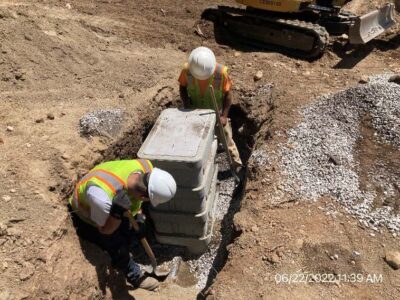 This Project includes the replacement of aged and undersized water and sewer lines serving nine (9) properties in the Forrest Glen and Hidden Lake subdivisions. The original sewer line was installed in 1976 as part of the Sewer Assessment District No. 2 and the original waterline was installed sometime in the 1960s. Both the water and sewer mains are located in back and side yard easements.
This Project includes the replacement of aged and undersized water and sewer lines serving nine (9) properties in the Forrest Glen and Hidden Lake subdivisions. The original sewer line was installed in 1976 as part of the Sewer Assessment District No. 2 and the original waterline was installed sometime in the 1960s. Both the water and sewer mains are located in back and side yard easements.
The sewer project included replacement of approximately 300-feet of 4-inch and 8-inch asbestos concrete pipe sewer main located within back and side yard easements. Much of the line was located outside of the existing easements and presented difficulties for operations staff to access and maintain. The project replaced the existing sewer line with 6-inch pipe while placing it in the center of the easements.
The waterline replaced was a 2-inch galvanized steel pipe. The pipeline was a dead end line that had been the source of numerous water quality complaints by those customers utilizing it. The waterline also did not meet State water works standards for a minimum diameter of 4-inches. The project replaced approximately 350-feet of the existing 2-inch line and installed an additional 300-feet of new 6-inch waterline to create a looped system from a 12-inch water main in Olympic Valley Road to the Hidden Lake subdivision. The waterline loop and provides additional water supply and fire suppression reliability and redundancy to the Hidden Lake subdivision.
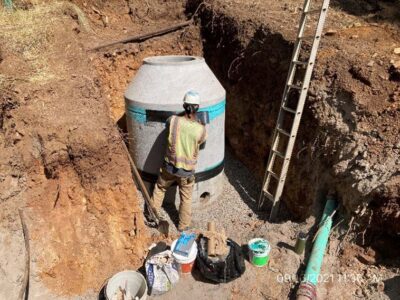
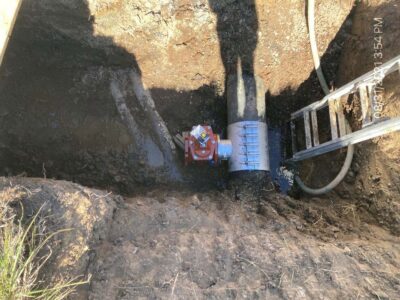
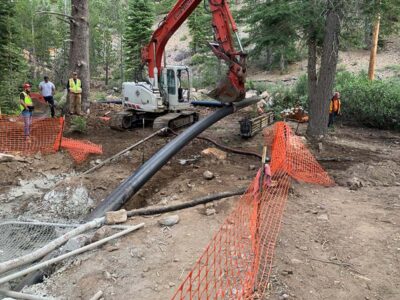 Until the mid-seventies, there were three sewage treatment plants in operation in Olympic Valley. In 1976, when the Tahoe-Truckee Sanitation Agency (TTSA) was formed, a trunk pipeline, known as the Truckee River Interceptor (TRI), was constructed along the Truckee River to convey sewage from Tahoe City, Alpine Meadows, and Olympic Valley to a regional wastewater treatment facility in Truckee. Installed at the same time was the Olympic Valley Interceptor, a pipeline ranging in size from 10 to 15 inches in diameter, running from the Village to the TRI on the east side of the Truckee River.
Until the mid-seventies, there were three sewage treatment plants in operation in Olympic Valley. In 1976, when the Tahoe-Truckee Sanitation Agency (TTSA) was formed, a trunk pipeline, known as the Truckee River Interceptor (TRI), was constructed along the Truckee River to convey sewage from Tahoe City, Alpine Meadows, and Olympic Valley to a regional wastewater treatment facility in Truckee. Installed at the same time was the Olympic Valley Interceptor, a pipeline ranging in size from 10 to 15 inches in diameter, running from the Village to the TRI on the east side of the Truckee River.
The District has been responsible for the line in Olympic Valley since its construction in 1978. Part of the Olympic Valley Interceptor includes the Truckee River Siphon. The Siphon begins approximately 0.5 mile north of the entrance to Olympic Valley on the west side of Highway 89 and extends under the highway and under the Truckee River, terminating on the east side of the Truckee River.
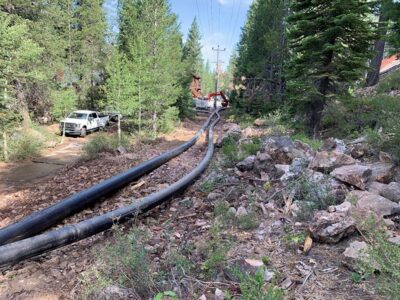 The Truckee River Siphon is arguably the most critical asset in the District’s sewer collection system and is the final segment of the Olympic Valley Interceptor. Unlike other sewer pipelines in the Valley, maintenance and repair of the old siphon posed major challenges to the District’s operations staff, requiring sewer bypass piping with difficult access.
The Truckee River Siphon is arguably the most critical asset in the District’s sewer collection system and is the final segment of the Olympic Valley Interceptor. Unlike other sewer pipelines in the Valley, maintenance and repair of the old siphon posed major challenges to the District’s operations staff, requiring sewer bypass piping with difficult access.
Past inspections indicated that the Siphon was reaching the end of its useful life. A high-resolution, 360-degree, panoramic television inspection was performed on the Siphon in 2016 which revealed multiple areas of lining failure. As the Siphon’s coating continued to deteriorate, the pipe’s likelihood of failure increased. As a matter of public health and safety, it was imperative that the Truckee River Siphon be replaced to provide the necessary reliability and redundancy to support the needs of the residents of Olympic Valley.
The project included installing two (2) sewer pipelines under Highway 89 and the Truckee River. The parallel pipelines provide the District with redundancy and reliability to handle all of the flow conditions in the Valley from now into the future and improve the ease of operations and maintenance activities. In order to minimize disturbance to the Highway and Truckee River bed, the District chose to construct the project using Horizontal Directional Drilling which greatly minimized the environmental and traffic impacts of the project. This method steered a drill bit across and below the highway and river bottom to produce a small diameter pilot hole which is then reamed out to accommodate the size of the new pipe. Low-pressure drilling fluid (bentonite clay) was used to maintain the bore hole and prevent frac-out. The pipelines were laid out above ground and pulled through the hole to their final location. The construction activities for drilling/reaming and subsequent installation of the new pipes occurred outside of the river channel and 100-year floodplain, back from each bank of the river.
The District awarded a construction contract in February 2019 for $1,711,000. The project was successfully completed in November 2019 and came in under budget with a final construction cost of $1,650,000!
